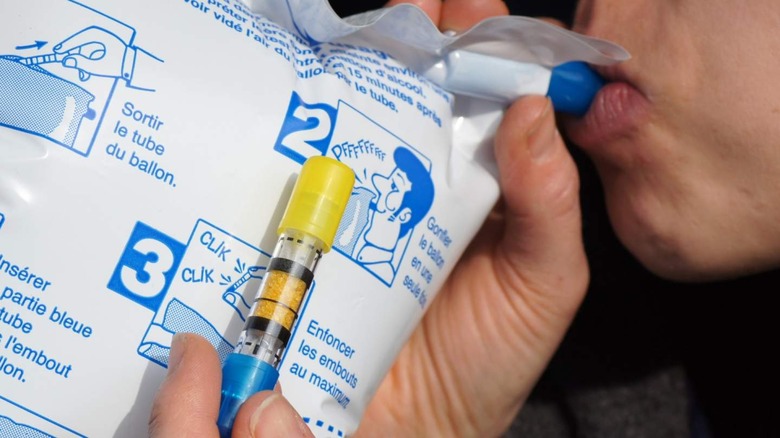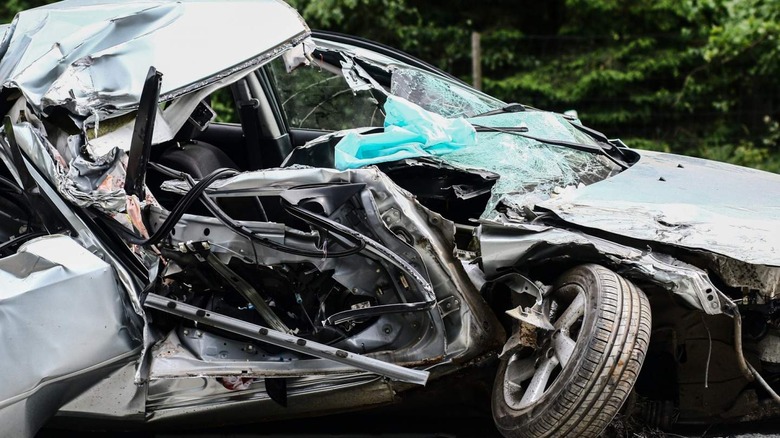New Regulations Could Mandate Vehicle Tech To Prevent Drunk Driving
There's been much talk about the infrastructure bill being fought over in Washington. There is a provision in the infrastructure law seeking to mandate all vehicles integrate technology to help prevent drunk driving in the near future. If the law moves forward with provisions in place, automotive manufacturers would be required to incorporate technology to stop vehicle owners from driving while under the influence of alcohol (via NPR).
Exactly how automotive manufacturers would handle that mandate remains to be seen, but a few different types of technology could work. Law enforcement around the US already has the ability to order a vehicle owner to integrate technology, such as breathalyzers, into their vehicles if they are convicted of driving while intoxicated.
Current Technologies
A common current technology used to prevent drivers from driving under the influence of alcohol is a breathalyzer starter interlock system. This type of technology prevents the vehicle from being started until the driver blows into an interlock device that measures alcohol content in the breath. If the driver blows into the device and blood alcohol levels are too high, the vehicle won't start.

Anyone who's seen a vehicle equipped with a breathalyzer knows those devices are typically attached to the vehicle via a cord. Should the mandate pass, this type of breathalyzer technology would not be used because the mandate requires passive systems. A system under development as a joint project between automotive manufacturers and the federal government is the Driver Alcohol Detection System for Safety (DADSS). It uses sensors built into the dashboard or window to detect alcohol without the driver having to blow into a tube. The technology would be able to differentiate the driver from passengers.
There are limitations to traditional vehicle breathalyzers, which is why the DADSS system is being developed. All the driver has to do to get a vehicle fitted with a conventional breathalyzer to start and drive away is have someone else who hasn't been drinking blow into the device. Convicted DWI offenders frequently bypass devices of this type to continue drinking and driving. The DADSS system would prevent that.
Another potential technology to help detect drivers operating a vehicle under the influence of alcohol includes cameras in the vehicle that monitor the driver for signs of impairment. Similar technologies are already in place in many vehicles to monitor driver alertness to help detect if a driver is excessively sleepy. Research has shown that driving while drowsy is almost as dangerous as driving while intoxicated.

Another benefit of camera-based technology is that it can also potentially detect drivers attempting to operate a vehicle under the influence of drugs. Breathalyzer technology only detects alcohol, and someone high on drugs could still drive a vehicle under the influence. The downside to camera-based technology is that many people are staunchly against any camera-based technology observing them during their private lives.
An interesting alternative to a system that detects alcohol on the breath is a sensor able to detect alcohol in the blood. The sensor would shine a light through the driver's fingertip and be able to detect alcohol based on reflected light. Healthcare providers have used similar technology for decades to detect oxygen levels in the blood via a device called a pulse oximeter.

Sensors of this type could be integrated into the steering wheel or other surface of the car requiring the driver to place their finger on the sensor before the vehicle starts. However, this type of system would raise the question of how vehicle manufacturers prevent a passenger from substituting their finger for the driver's.
Timeframe
While the potential mandate is looming, many of these technologies are still in the prototype stage. There's also the possibility that federal regulators will mandate a specific type of technology in the future. Likely, any new vehicles with integrated technology to prevent driving under the influence of drugs or alcohol are at least five years away. The mandate states that the technology must be passive, meaning the current type of breathalyzer devices integrated into some vehicles owned by those convicted of a DWI wouldn't meet the requirements.
The goal behind the mandate would be to make the system unobtrusive, so that vehicle owners who aren't driving under the influence never notice it's there. However, there will undoubtedly be those who oppose mandated technologies, particularly camera-based technologies, over privacy concerns. Another issue with any new required safety systems is how much they will drive up the price of new vehicles. Automotive prices are already soaring, and with other mandates requiring a move to electric vehicles, prices are likely to increase even higher in the future.
